NCERT Solutions for Class 7 English Unit 2 A Funny Man
| Table of contents |

|
| Let us do these activities before we read. |

|
| Let us discuss |

|
| Let us think and reflect |

|
| Let us learn |

|
| Let us listen |

|
| Let us speak |

|
| Let us write |

|
| Let us explore |

|
Let us do these activities before we read.
Look around you for things or people that make you laugh. Write them in the bubbles given below. Share the reasons for your answers with your classmates and the teacher.
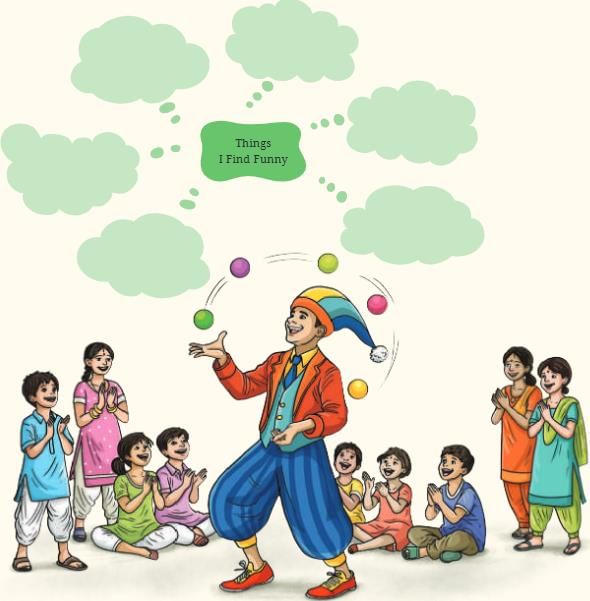 Ans: Here are six things or people around me that make me laugh, along with reasons why they’re funny.
Ans: Here are six things or people around me that make me laugh, along with reasons why they’re funny.
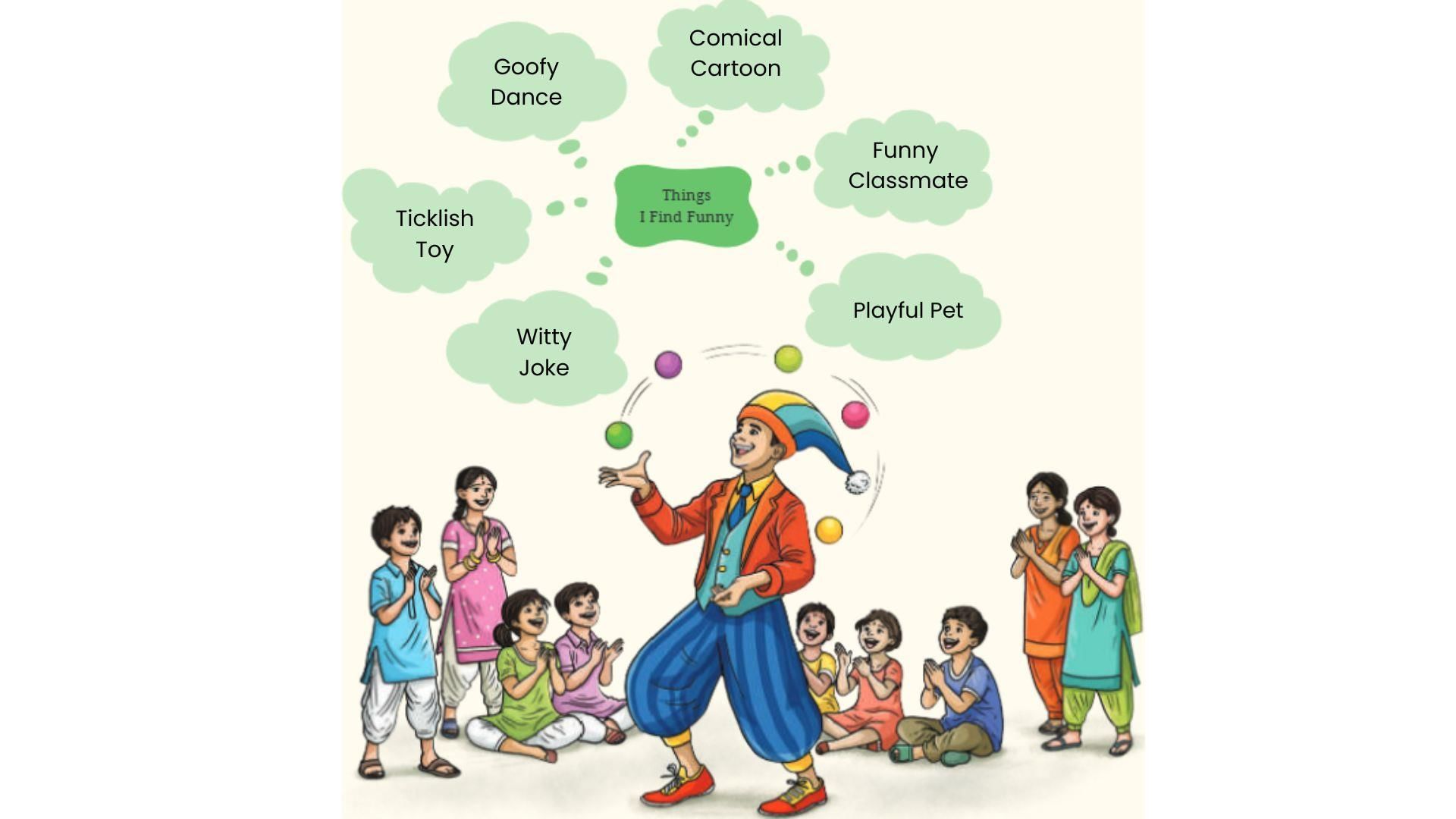 1. A Playful Pet
1. A Playful Pet
Reason: My dog chases its tail in circles, thinking it’s a game, which is hilarious because it never catches it but keeps trying with such enthusiasm!
2. A Funny Classmate
Reason: My friend makes silly faces during boring lessons, mimicking the teacher’s expressions, which cracks everyone up without getting caught.
3. A Comical Cartoon on TV
Reason: Watching a cartoon like Tom and Jerry is funny because Tom’s plans to catch Jerry always fail in the most ridiculous, over-the-top ways.
4. A Sibling’s Goofy Dance
Reason: My younger sibling dances wildly to any music, flailing arms and legs like a robot gone haywire, making everyone laugh at their confidence.
5. A Ticklish Toy
Reason: A toy that makes weird noises or wiggles when you press it, like a giggling plushie, is funny because it surprises you every time.
6. A Teacher’s Witty Joke
Reason: My teacher sometimes tells cheesy jokes, like “Why did the cow become a motivational speaker? Because it was outstanding in its field!”—it’s so bad it’s funny.
Let us discuss
QI: Work in pairs. Identify the true statements. Check your answers with the teacher.
1. The poet says that she had never heard such an amusing song.
2. The funny man was quite ill-mannered.
3. The funny man wore two hats on his feet.
4. The funny man hopped on his head to reach home.
5. The funny man gave a rose to the poet.
6. The funny man smiled at the poet.
Ans:
1. Statement 1 is true: The poet says, "You never heard in all your life Such a funny feeling sound."
2. Statement 2 is false: The funny man was polite, not ill-mannered.
3. Statement 3 is true: The poem states, "He wore… hats upon his feet."
4. Statement 4 is true: The funny man "hopped home on his head."
5. Statement 5 is false: He gave a currant bun, not a rose.
6. Statement 6 is true: "He raised the shoe and smiled at me."
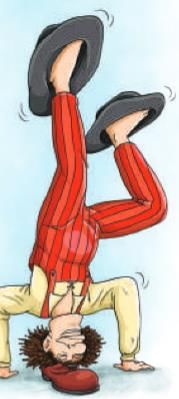 QII: Identify the words from the poem based on the meanings given. Share your answers with your classmates and the teacher.
QII: Identify the words from the poem based on the meanings given. Share your answers with your classmates and the teacher.
1. a small seedless raisin – C _ R _ _ _ T
Ans: Currant
2. moved unsteadily - S _ _ G G _ _ _ D
Ans: Staggered
Explanation:
- "Currant" is from "currant bun," a small seedless raisin.
- "Staggered" is from "I staggered back," meaning moved unsteadily.
QIII: Complete the following sentences with a reason.
1. The tone of the poem is ___________ because ___________.
2. The rhyme scheme of the poem is ___________; and it gives a ___________quality to the poem.
3. The poet has frequently repeated the word ‘funny’ in order to___________.
Ans:
1. The tone of the poem is funny because the funny man does silly things like wearing hats on his feet and hopping on his head.
2. The rhyme scheme of the poem is AABB; and it gives a playful quality to the poem.
3. The poet has frequently repeated the word 'funny' in order to make the poem humorous and show the man’s silly actions.
QIV: Choose the correct answer from the options given in the brackets.
1. The poem uses vivid imagery to create a _______________________(humorous and nonsensical/ confusing but thought-provoking) scene.
2. The structure of the poem is in ___________ (monologue/ dialogue) form.
3. The phrases ‘sounding sight’ and ‘hopped home’ are examples of___________. (alliteration/simile)
Ans:
1. The poem uses vivid imagery to create a humorous and nonsensical scene.
2. The structure of the poem is in dialogue form.
3. The phrases 'sounding sight' and 'hopped home' are examples of alliteration.
QV: Rewrite the following line from the poem in the correct order.
1. But never had I seen before
Such a funny sounding sight
Ans: I had never seen such a funny-sounding sight before.
The original line "But never had I seen before Such a funny sounding sight" is rewritten in natural order.
2. Why has the poet used phrases like ‘funny sounding sight’ and ‘funny feeling sound’ with reference to the funny man?
Ans: The poet uses these phrases to make the funny man’s actions seem silly and strange. "Funny sounding sight" describes the odd way he looks, like wearing hats on his feet, which is unusual to see. "Funny feeling sound" shows his song sounds weird and makes the poet laugh. These phrases add humour and show how the funny man’s behaviour is playful and not normal.
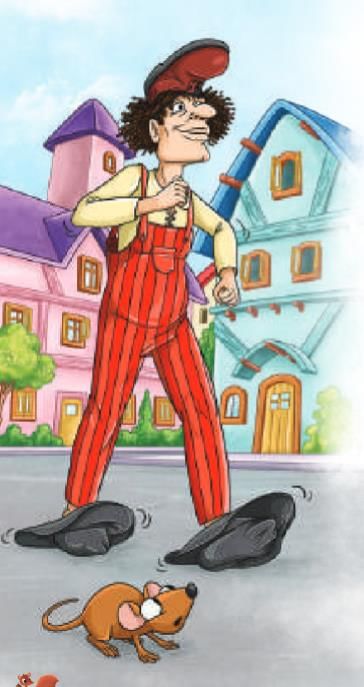 QVI: Can you think of any real-world situations where people do similar things for fun, entertainment, or performance? Share with your classmates and the teacher.
QVI: Can you think of any real-world situations where people do similar things for fun, entertainment, or performance? Share with your classmates and the teacher.
Ans: Several real-world examples mirror the funny man’s behaviour:
- Clowns at a circus wear funny costumes and do silly acts to make people laugh, like the funny man.
- Street performers juggle or dress oddly to entertain, similar to the funny man’s actions.
Let us think and reflect
QI: Read the extracts given below and answer the questions that follow.
1. He said, “Allow me to present Your Highness with a rose.”
And taking out a currant bun
He held it to my nose.
I staggered back against the wall
And then I answered, “Well!”
(i): Why does the funny man address the poet as 'Your Highness'?
Ans: To be polite and playful.
(ii): Choose a phrase from the extract which indicates a polite request.
Ans: The funny man says, "Allow me to present Your Highness with a rose," which is a polite way to ask.
(iii): Choose the option which shows a 'currant bun'.

Ans: Image 2 likely represents a currant bun.
(iv): Complete the sentence with an appropriate reason.
When the poet says, 'Well!', it expresses surprise. This was so because ______
Ans: The funny man gave her a currant bun but called it a rose.
The poet was surprised because a currant bun doesn’t look or smell like a rose.
2. You never heard in all your life
Such a funny feeling sound.
“My friend, why do you wear two hats
Upon your feet?” I said.
He turned the other way about,
And hopped home on his head.
(i): Choose the line from the extract which tells us that the sound was unique.
Ans: "You never heard in all your life such a funny feeling sound."
This line shows the sound was unique because the poet had never heard it before.
(ii): Complete the sentence with an appropriate reason. The poet calls the funny man 'my friend' because __________
Ans: She wants to be friendly and ask him a question.
(iii): What does the reaction of the funny man to the poet's question tell us about him?
Ans: Instead of answering the question, he turns around and hops on his head. This shows us that he is silly and playful.
(iv): Choose the correct option to complete the sentence. The last line of the extract makes the readers feel ______
A. dreamy B. impatient C. worried D. cheerful
Ans: D. cheerful
The funny man hopping on his head is silly and makes readers smile, so it feels cheerful.
QII: Answer the following questions.
1: Which character trait of the funny man was most appealing to you? Why?
Ans: His playfulness. He does funny things like wearing hats on his feet and hopping on his head, which makes the poem enjoyable.
2: The funny man does unusual things in the poem. How does it affect the overall mood of the poem?
Ans: It makes the mood funny and light. His actions like giving a currant bun as a rose and hopping on his head create laughter.
3: What alternative title would you suggest for the poem? Give reason(s) for your choice.
Ans: "The Silly Man’s Adventure" because the funny man does silly things like wearing a shoe on his head and singing a funny song.
4: Why do you think the poet has included dialogues in the poem?
Ans: To make the poem lively and show the funny man’s actions directly. Lines like "I said" and "He said" make it more engaging.
5: What does the poet wish to convey by highlighting the unusual behaviour of the funny man?
Ans: The poet wants to show that being silly can bring joy. The funny man’s actions, like wearing hats on his feet, make people smile.
Let us learn
Read the following phrases from the poem.
• walking down • taking out • sat down
These are phrasal verbs.
Phrasal verbs are combinations of a verb with a preposition or adverb that together function as a single unit. They often have meanings that are different from the individual words used alone. The same verb followed by different prepositions or adverbs conveys different meanings.
QI: Match the phrasal verbs in Column 1 with their correct meaning in Column 2.
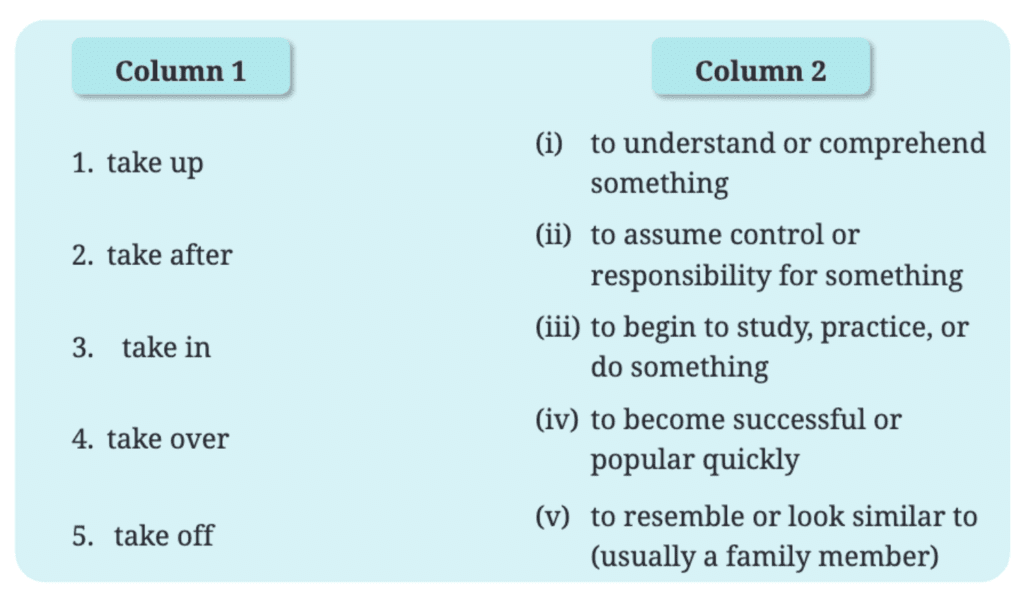
Ans: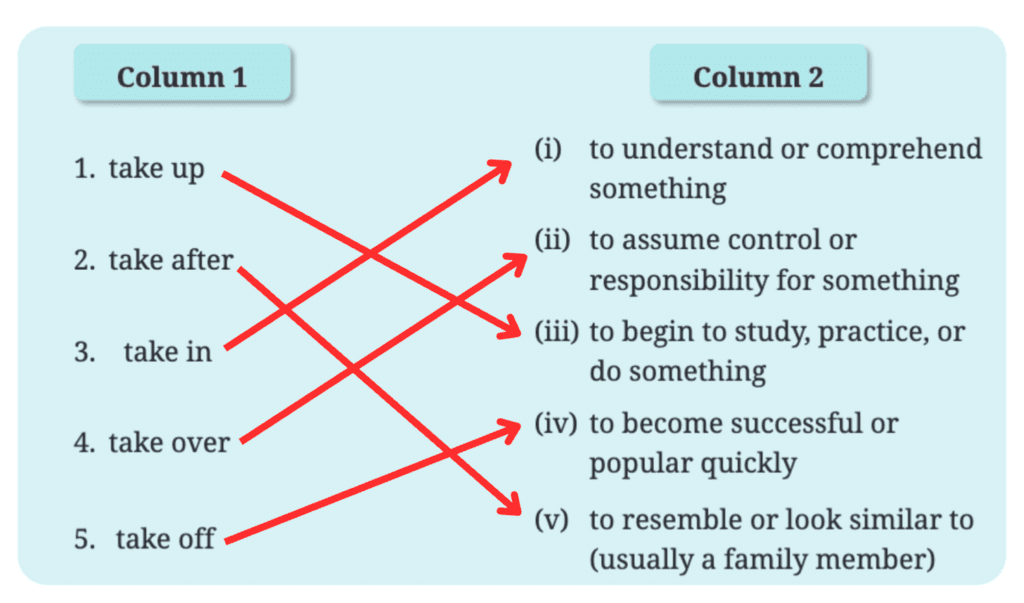
Now, fill in the blanks with suitable phrasal verbs from the table given in I. You may change the tense of the verb, if required.
1. The new technology is set to _________________ traditional methods of communication.
2. I tried hard to _________________ what the writer wanted to say but was unsuccessful.
3. Arjun decided to _________________ painting as a hobby.
4. The smartphone quickly _________________ the sales in the market.
5. Sheela _________________ her father; they have the same smile
Ans:
- The new technology is set to take over traditional methods of communication.
- I tried hard to take in what the writer wanted to say but was unsuccessful.
- Arjun decided to take up painting as a hobby.
- The smartphone quickly took off the sales in the market.
- Sheela takes after her father; they have the same smile.
QII: Match the verbs in Column 1 with any suitable adverbs or prepositions in Column 2. Write their meanings in Column 3. An example has been done for you.
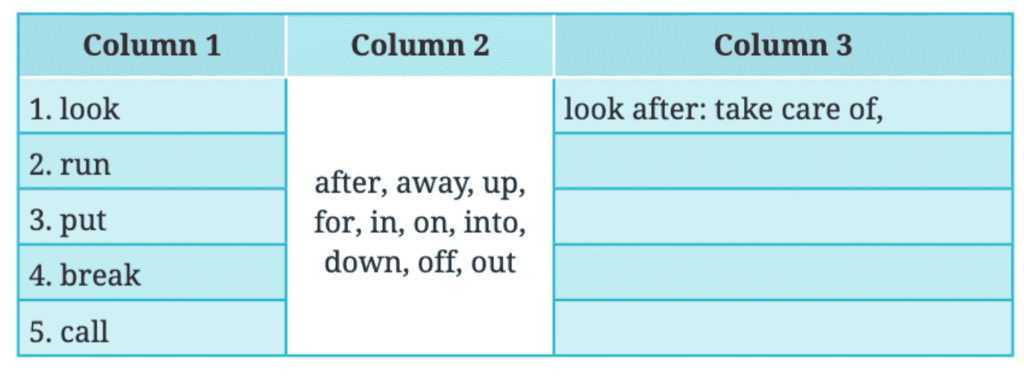
Ans:
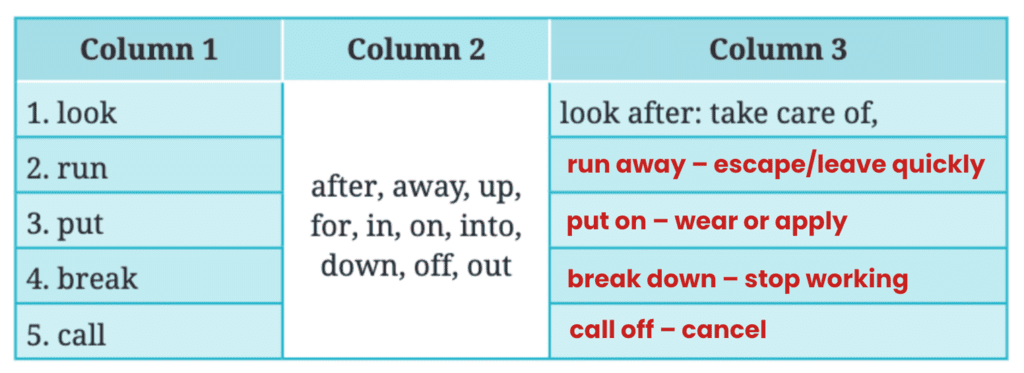
Now, frame sentences of your own using any five phrasal verbs.
Ans:
- I will look after my dog while my parents are away.
- The cat ran away when it heard a loud noise.
- She put on her jacket before going outside.
- The car broke down on the way to school.
- They called off the football match because of the rain.
QIII: Read the following words from the poem.
walking, staggered, hopped
The given words denote the different ways of walking. Arrange the words given in the box in increasing order of pace.
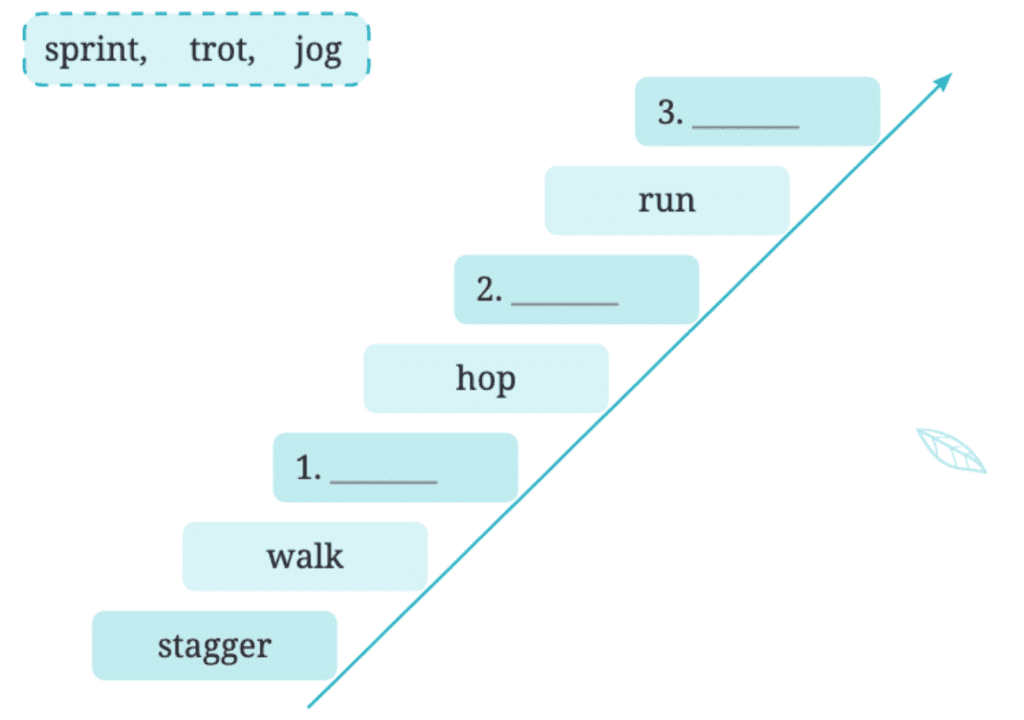
Ans:
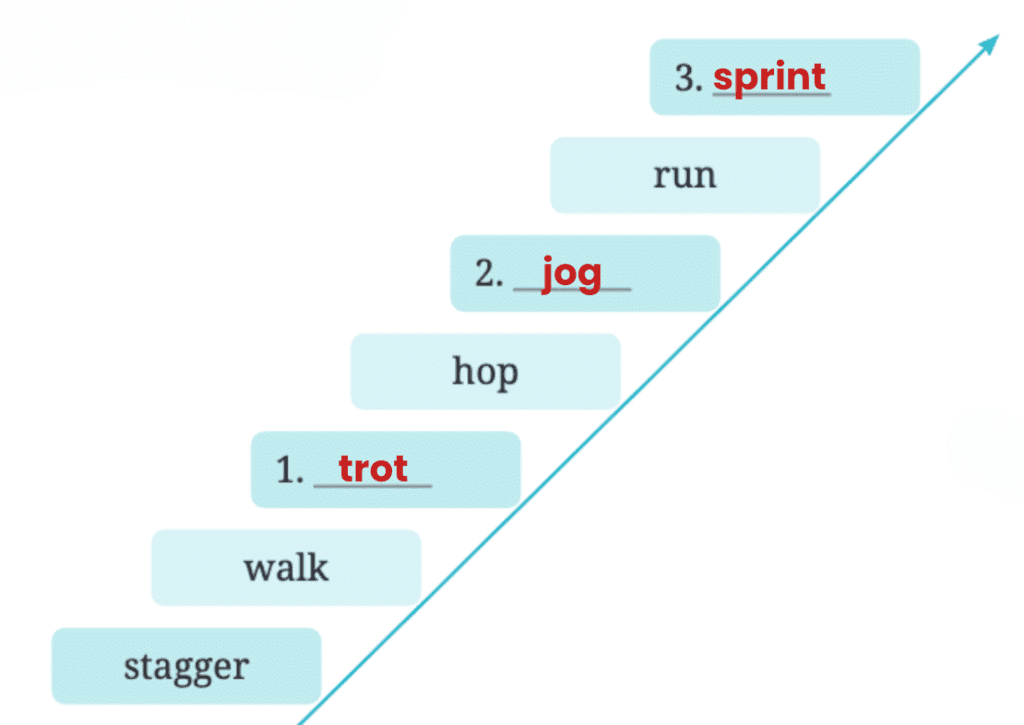
- stagger (very slow, unsteady)
- walk (steady, normal speed)
- trot (a bit faster than jogging, like a horse’s light run)
- hop (move by jumping)
- jog (light running)
- run (fast, strong pace)
- sprint (the fastest burst of speed)
Let us listen
I) You will listen to a girl narrate a personal incident. As you listen, select the picture related to the narration. (Transcript for the teacher on pg. 88)
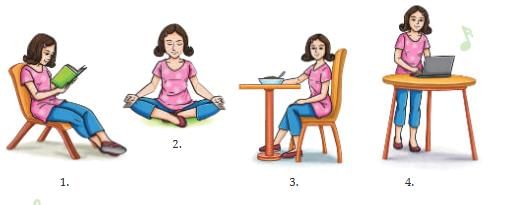
Transcript: Hello. This is quite a funny incident. One day, I was so preoccupied with preparing for my presentation. After a long day of studying at a friend’s place, I finally came home. Exhausted, I removed my shoes at the door and headed straight to the kitchen for some lunch. I served myself dal-chawal and ate it, still thinking about all the topics I needed to cover.
Once I finished my lunch, I got up to put my shoes away in my room and placed my plate in the kitchen. However, being so preoccupied, I ended up doing the opposite! I walked to my room with my plate in hand and left it on my desk. Then, I took my shoes and placed them in the kitchen!
As I stood there, confused, I realised what I had done. I couldn’t help but laugh at myself. I shook my head, recovered my shoes from the kitchen and kept the plate in the kitchen.
Ans: The correct picture is picture 3 where the girl can be seen eating food.
II) You will once again listen to the girl narrate a personal incident. As you listen, arrange the events in order of occurrence.
1. Ate lunch
2. Took off shoes
3. Put shoes in the room
4. Laughed at the mistake
5. Placed the plate in the room
6. Prepared for the presentation
7. Put the plate in the kitchen
Ans: Here is the correct order of events based on the narration:
6 → 2 → 1 → 5 → 4 → 3 → 7
- 6. Prepared for the presentation (at her friend’s place before coming home)
- 2. Took off shoes (as soon as she got home)
- 1. Ate lunch (served dal-chawal in the kitchen)
- 5. Placed the plate in the room (she did this by mistake, carrying it to her desk)
- 4. Laughed at the mistake (when she realised the mix-up)
- 3. Put shoes in the room (she then fetched them back from the kitchen)
- 7. Put the plate in the kitchen (finally returned the plate to its proper place)
Let us speak
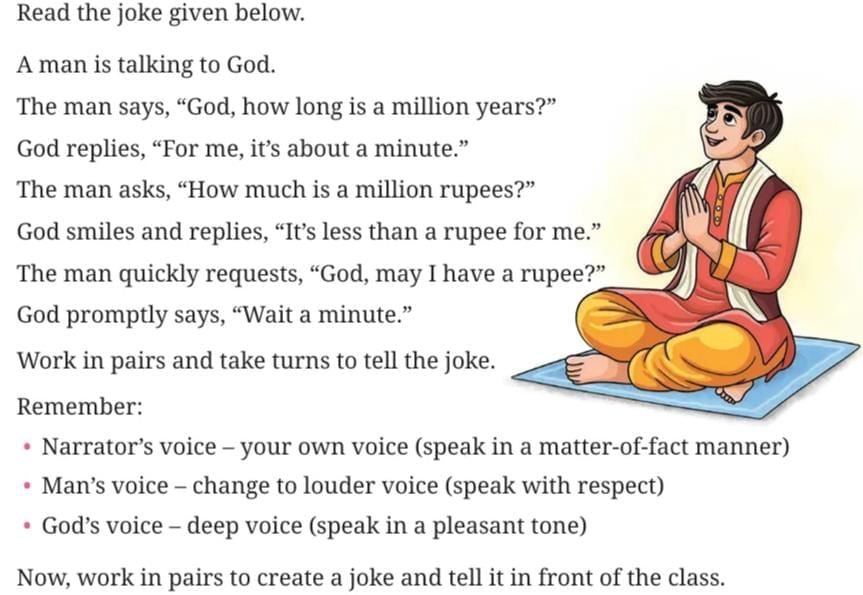
Ans: Here’s an original joke for you and your partner to practice and perform:
- Narrator: A cat visits a wise owl in the forest.
- Cat (in a curious, meowing tone): “Owl, why do you stay up all night?”
- Owl (in a slow, hooting tone): “Because the night is when I’m wide awake!”
- Cat (excitedly): “Can you teach me to stay up like you?”
- Owl (with a chuckle): “Sure, but you’ll need to catch a nap first!”
Performance Tips:
- Narrator: Speak in your natural voice, calmly setting up the scene.
- Cat’s Voice: Use a high-pitched, playful tone to mimic a curious cat.
- Owl’s Voice: Use a slow, deep tone to sound wise and slightly amused.
- Practice switching roles, emphasising the punchline (“catch a nap first”) with a pause for effect.
- Perform confidently in front of the class, using gestures like mimicking a cat’s whiskers or an owl’s head turn to make it funnier.
Sharing with Class: After performing, explain why you chose the characters and punchline (e.g., “We picked a cat and owl because their opposite sleep habits make a funny contrast”). Encourage classmates to share their jokes, creating a lively, humorous class session.
Let us write
QI: A limerick is a nonsensical and funny verse consisting of five lines. Study the limerick given below and identify the rhyme scheme.
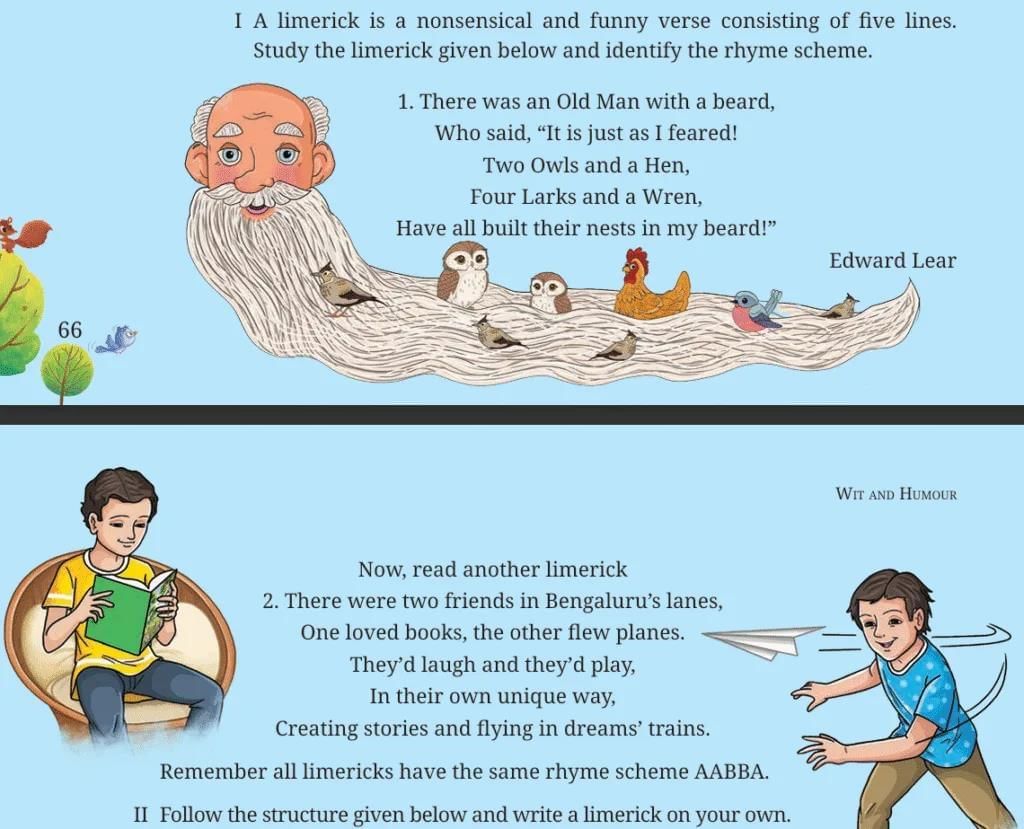
Ans: The rhyme scheme is AABBA.
Lines 1, 2, and 5 rhyme ("beard," "feared," "beard"), and lines 3 and 4 rhyme ("Hen," "Wren").
QII: Follow the structure given below and write a limerick on your own.
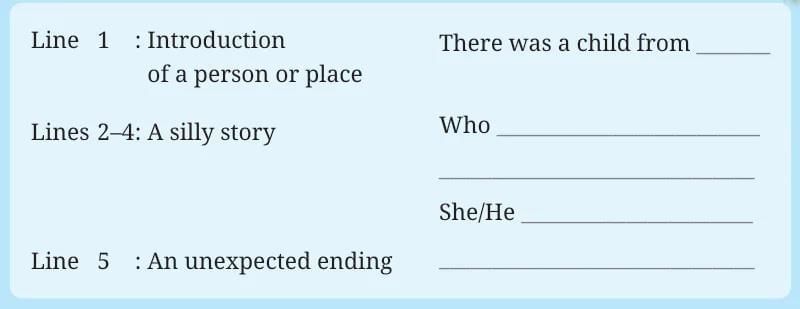
Ans:
There was a child from the city,
Who loved to chase a small kitty,
It ran up a tree,
The child laughed with glee,
But fell in the mud—what a pity!
Let us explore
I) In ancient Indian literature and mythology, there are several humorous or funny characters who play important roles in the stories. These characters often represent wit, humour and mischief while conveying deeper moral lessons. Here are a few well-known funny characters:

Take any story to read and share it with your classmates and the teacher.
Ans:
1. Tenali Rama – The Thief’s Advice
Once, a rich man asked King Krishnadevaraya to guard his house because he was afraid of thieves.
The king sent Tenali Rama.
Tenali wrote a note and stuck it on the door. It read:
“I know you are planning to rob this house. Come tomorrow.”
That night, the thief read the note and ran away!
He never came back.
Moral: Use cleverness, not anger, to solve problems.
2. Birbal – The Wise Answer
One day, Emperor Akbar asked,
“Birbal, can you tell me how many crows are in my kingdom?”
Birbal smiled and said,
“There are eighty-five thousand, four hundred and seventy-three crows, Jahanpanah.”
The king laughed, “What if there are more?”
Birbal said, “Then some must be visiting their relatives in other cities.”
Akbar clapped and laughed loudly.
Moral: Quick thinking and confidence can win hearts.
3. Mullah Nasruddin – The Coat at the Feast
One day, Mullah Nasruddin went to a feast in old clothes. No one greeted him.
So he went home, wore his best coat, and came back.
Now everyone welcomed him warmly.
While eating, he said,
“Eat coat, eat!”
People were shocked.
He said, “You didn’t welcome me, you welcomed my coat!”
Moral: Never judge people by their clothes or looks.
4. King Vikramaditya & Betal – The Clever Prince
Betal told King Vikramaditya a story:
A king had two sons. One was strong and brave. The other was kind and wise.
The king had to choose who would become the next king.
Question: Who should the king choose?
Vikramaditya replied,
“The kind and wise one, because strength fades, but kindness lasts.”
Betal smiled and flew back to the tree!
Moral: Wisdom and kindness are more powerful than strength.
II) We can identify the acts of the funny man with certain modern-day activities that have playfulness or unconventional behaviour. For example:
- Street Performers or Clowns: Like the funny man in the poem, modern-day street performers or clowns often dress in unusual ways and do unexpected acts to entertain people.
- Performance Art or Abstract Theatre: The funny man’s actions, such as singing a song and hopping on his head, resemble performance art or abstract theatre, where artists break conventional rules to create thought-provoking, often humorous experiences.
- Children’s Entertainment and Comedy Shows: The funny man’s behaviour is reflected in children’s shows to evoke laughter. In these examples, the common theme is humour, imagination, and defying logic or expectation, which is exactly what the funny man in the poem represents.
Ans: In all these activities, the main idea is to use humour, creativity, and surprise, just like the funny man in the poem.
III) Sukumar Ray, an Indian poet and illustrator, wrote poems in a similar style in his book Abol Tabol. You may also share a similar poem from your native language with your classmates and the teacher.
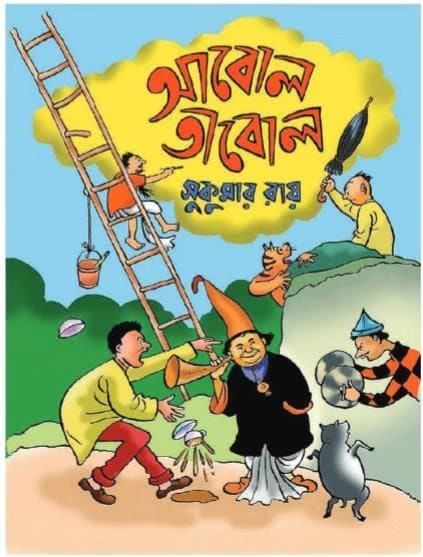
Ans: This page introduces Sukumar Ray, the famous Indian poet and illustrator, known for his nonsense poems in the book Abol Tabol (আবোল তাবোল). These poems are funny, imaginative, and often silly, just like limericks. They are written in Bengali, and children love them for their rhymes, rhythms, and humour.
About Sukumar Ray
- Sukumar Ray was a Bengali poet, artist, and storyteller.
- He wrote poems that were full of fun, silly characters, and strange things.
- His poems like “Khai-Khai,” “Pagla Dashu,” and “Gonph Churi” make children laugh and think at the same time.
Sample (Nonsense-style Poem in English)
Here’s a poem inspired by Sukumar Ray’s style:
There once was a tiger named Ticky,
Who danced every time it got sticky.
He wore a red hat,
Sang songs to a cat,
And said, “Being weird is just tricky!”
IV) Read and enjoy the poem
My Lost Pencil
Oh pencil, dear pencil, where have you gone?
I just had you here a minute at dawn!
You were sharp and perfect, ready to write,
Now you’re missing—gone from sight!
Did you roll off my desk?
Did you fall to the floor?
Did someone swipe you for sure?
It’s always the same, I’ve lost fifty this year,
By the end of the month, they just disappear!
Next time, I’ll tie you with tape or a string,
Because losing my pencils is a real thing.

|
55 videos|465 docs|76 tests
|
FAQs on NCERT Solutions for Class 7 English Unit 2 A Funny Man
| 1. What is the main theme of the story "A Funny Man"? |  |
| 2. Who are the key characters in "A Funny Man"? |  |
| 3. How does the protagonist of "A Funny Man" use humor to solve problems? |  |
| 4. What lesson can readers learn from "A Funny Man"? |  |
| 5. How does the author use language to convey humor in "A Funny Man"? |  |

















